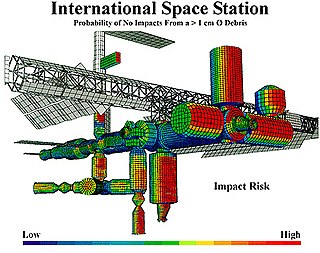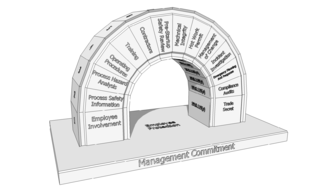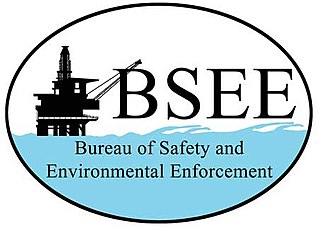Related Research Articles

Safety engineering is an engineering discipline which assures that engineered systems provide acceptable levels of safety. It is strongly related to industrial engineering/systems engineering, and the subset system safety engineering. Safety engineering assures that a life-critical system behaves as needed, even when components fail.
Broadly speaking, a risk assessment is the combined effort of:
- identifying and analyzing potential (future) events that may negatively impact individuals, assets, and/or the environment ; and
- making judgments "on the tolerability of the risk on the basis of a risk analysis" while considering influencing factors.

A chemical hazard is a type of occupational hazard caused by exposure to chemicals in the workplace. Exposure to chemicals in the workplace can cause acute or long-term detrimental health effects. There are many types of hazardous chemicals, including neurotoxins, immune agents, dermatologic agents, carcinogens, reproductive toxins, systemic toxins, asthmagens, pneumoconiotic agents, and sensitizers. These hazards can cause physical and/or health risks. Depending on chemical, the hazards involved may be varied, thus it is important to know and apply the PPE especially during the lab.

Process safety managementsystem is a regulation promulgated by the U.S. Occupational Safety and Health Administration (OSHA). A process is any activity or combination of activities including any use, storage, manufacturing, handling or the on-site movement of highly hazardous chemicals (HHCs) as defined by OSHA and the Environmental Protection Agency.
ALARP, which stands for "as low as reasonably practicable", or ALARA, is a term often used in the regulation and management of safety-critical and safety-involved systems. The ALARP principle is that the residual risk shall be reduced as far as reasonably practicable. In UK and NZ Health and Safety law, it is equivalent to SFAIRP.

Lock Out, Tag Out (LOTO), Lock Out, Tag Out, Try Out (LOTOTO) or lock and tag is a safety procedure used in industry and research settings to ensure that dangerous machines are properly shut off and not able to be started up again prior to the completion of maintenance or repair work. It requires that hazardous energy sources be "isolated and rendered inoperative" before work is started on the equipment in question. The isolated power sources are then locked and a tag is placed on the lock identifying the worker who placed it. The worker then holds the key for the lock, ensuring that only he or she can remove the lock and start the machine. This prevents accidental startup of a machine while it is in a hazardous state or while a worker is in direct contact with it.
A hazard analysis is used as the first step in a process used to assess risk. The result of a hazard analysis is the identification of different type of hazards. A hazard is a potential condition and exists or not. It may in single existence or in combination with other hazards and conditions become an actual Functional Failure or Accident (Mishap). The way this exactly happens in one particular sequence is called a scenario. This scenario has a probability of occurrence. Often a system has many potential failure scenarios. It also is assigned a classification, based on the worst case severity of the end condition. Risk is the combination of probability and severity. Preliminary risk levels can be provided in the hazard analysis. The validation, more precise prediction (verification) and acceptance of risk is determined in the Risk assessment (analysis). The main goal of both is to provide the best selection of means of controlling or eliminating the risk. The term is used in several engineering specialties, including avionics, chemical process safety, safety engineering, reliability engineering and food safety.

Underwater diving, as a human activity, is the practice of descending below the water's surface to interact with the environment. Immersion in water and exposure to high ambient pressure have physiological effects that limit the depths and duration possible in ambient pressure diving. Humans are not physiologically and anatomically well adapted to the environmental conditions of diving, and various equipment has been developed to extend the depth and duration of human dives, and allow different types of work to be done.
ISSOW stands for Integrated Safe System of Work. An Integrated Safe System of Work is used in hazardous industry to request, review, approve and document tasks to be carried out by frontline workers. It integrates Permit-To-Work, Risk Assessment and Isolation Management under a single electronic system, providing safety improvements to the user.
A job safety analysis (JSA) is a procedure which helps integrate accepted safety and health principles and practices into a particular task or job operation. In a JSA, each basic step of the job is to identify potential hazards and to recommend the safest way to do the job. Other terms used to describe this procedure are job hazard analysis (JHA) and job hazard breakdown.
ISO 26262, titled "Road vehicles – Functional safety", is an international standard for functional safety of electrical and/or electronic systems in production automobiles defined by the International Organization for Standardization (ISO) in 2011.

The Bureau of Safety and Environmental Enforcement is an agency under the United States Department of the Interior. Established in 2011, BSEE is the lead agency in charge of improving safety and ensuring environmental protection relating to the offshore energy industry, mainly natural gas and oil, on the United States Outer Continental Shelf (OCS). The agency exercises the safety and environmental enforcement functions formerly under the Minerals Management Service including the authority to inspect, investigate, summon witnesses and produce evidence, levy penalties, cancel or suspend activities, and oversee safety, response, and removal preparedness.

Offshore oil spill prevention and response is the study and practice of reducing the number of offshore incidents that release oil or hazardous substances into the environment and limiting the amount released during those incidents.

Commercial offshore diving, sometimes shortened to just offshore diving, generally refers to the branch of commercial diving, with divers working in support of the exploration and production sector of the oil and gas industry in places such as the Gulf of Mexico in the United States, the North Sea in the United Kingdom and Norway, and along the coast of Brazil. The work in this area of the industry includes maintenance of oil platforms and the building of underwater structures. In this context "offshore" implies that the diving work is done outside of national boundaries. Technically it also refers to any diving done in the international offshore waters outside of the territorial waters of a state, where national legislation does not apply. Most commercial offshore diving is in the Exclusive Economic Zone of a state, and much of it is outside the territorial waters. Offshore diving beyond the EEZ does also occur, and is often for scientific purposes.

Hydraulic fracturing in the United Kingdom started in the late 1970s with fracturing of the conventional oil and gas fields of the North Sea. It has been used in about 200 British onshore oil and gas wells since the early 1980s. The technique did not attract attention until licences use were awarded for onshore shale gas exploration in 2008.

Hierarchy of hazard control is a system used in industry to minimize or eliminate exposure to hazards. It is a widely accepted system promoted by numerous safety organizations. This concept is taught to managers in industry, to be promoted as standard practice in the workplace. Various illustrations are used to depict this system, most commonly a triangle.

The Offshore and Onshore Reliability Data (OREDA) project was established in 1981 in cooperation with the Norwegian Petroleum Directorate. It is "one of the main reliability data sources for the oil and gas industry" and considered "a unique data source on failure rates, failure mode distribution and repair times for equipment used in the offshore industr[y]. OREDA's original objective was the collection of petroleum industry safety equipment reliability data. The current organization, as a cooperating group of several petroleum and natural gas companies, was established in 1983, and at the same time the scope of OREDA was extended to cover reliability data from a wide range of equipment used in oil and gas exploration and production (E&P). OREDA primarily covers offshore, subsea and topside equipment, but does also include some onshore E&P, and some downstream equipment as well.
Engineering controls are strategies designed to protect workers from hazardous conditions by placing a barrier between the worker and the hazard or by removing a hazardous substance through air ventilation. Engineering controls involve a physical change to the workplace itself, rather than relying on workers' behavior or requiring workers to wear protective clothing.
Diving safety is the aspect of underwater diving operations and activities concerned with the safety of the participants. The safety of underwater diving depends on four factors: the environment, the equipment, behaviour of the individual diver and performance of the dive team. The underwater environment can impose severe physical and psychological stress on a diver, and is mostly beyond the diver's control. Equipment is used to operate underwater for anything beyond very short periods, and the reliable function of some of the equipment is critical to even short term survival. Other equipment allows the diver to operate in relative comfort and efficiency. The performance of the individual diver depends on learned skills, many of which are not intuitive, and the performance of the team depends on competence, communication and common goals.
The operations manual is the documentation by which an organisation provides guidance for members and employees to perform their functions correctly and reasonably efficiently. It documents the approved standard procedures for performing operations safely to produce goods and provide services. Compliance with the operations manual will generally be considered as activity approved by the persons legally responsible for the organisation.
References
- ↑ Staff. "HID Inspection Guide Offshore - Inspection of Control of Work arrangements" (PDF). HSE.gov.uk. Health and safety Executive. Retrieved 5 July 2017.
- ↑ Lardner, Ronny. "Human Failure in control of work: Plugging Holes In The Swiss Cheese?" (PDF). www.keilcentre.co.uk. Retrieved 5 July 2017.
- ↑ "Permit to Work (Form)". Explosive Industry Group. Archived from the original on 2017-08-11. Retrieved 5 July 2017.
- ↑ "Archived copy". Archived from the original on 2012-09-28. Retrieved 2012-09-23.CS1 maint: archived copy as title (link)
- ↑ "HMS Artemis - Lessons Learned". Archived from the original on 2008-05-24. Retrieved 2012-09-23.
- ↑ "Archived copy" (PDF). Archived from the original (PDF) on 2012-10-20. Retrieved 2012-09-23.CS1 maint: archived copy as title (link)
- ↑ Staff. "Permit to Work Systems". Health and Safety Executive. Retrieved 5 July 2017.
- ↑ "Offshore Petroleum and Greenhouse Gas Storage (Safety) Regulations 2009". Federal Register of Legislation. Australian Government. Retrieved 5 July 2017.
- ↑ "Standard Number: 1910.147 - The control of hazardous energy (lockout/tagout)". Occupational Safety and Health Standards, Subpart: J, General Environmental Controls. Retrieved 5 July 2017.
- ↑ "Petroleum and natural gas industries - Offshore production installations - Guidelines on tools and techniques for hazard identification and risk assessment". ISO 17776:2000. International Standards Organisation. Retrieved 5 July 2017.
- ↑ "European Industrial Gases Association - EIGA" (PDF). European Industrial Gases Association - EIGA.
